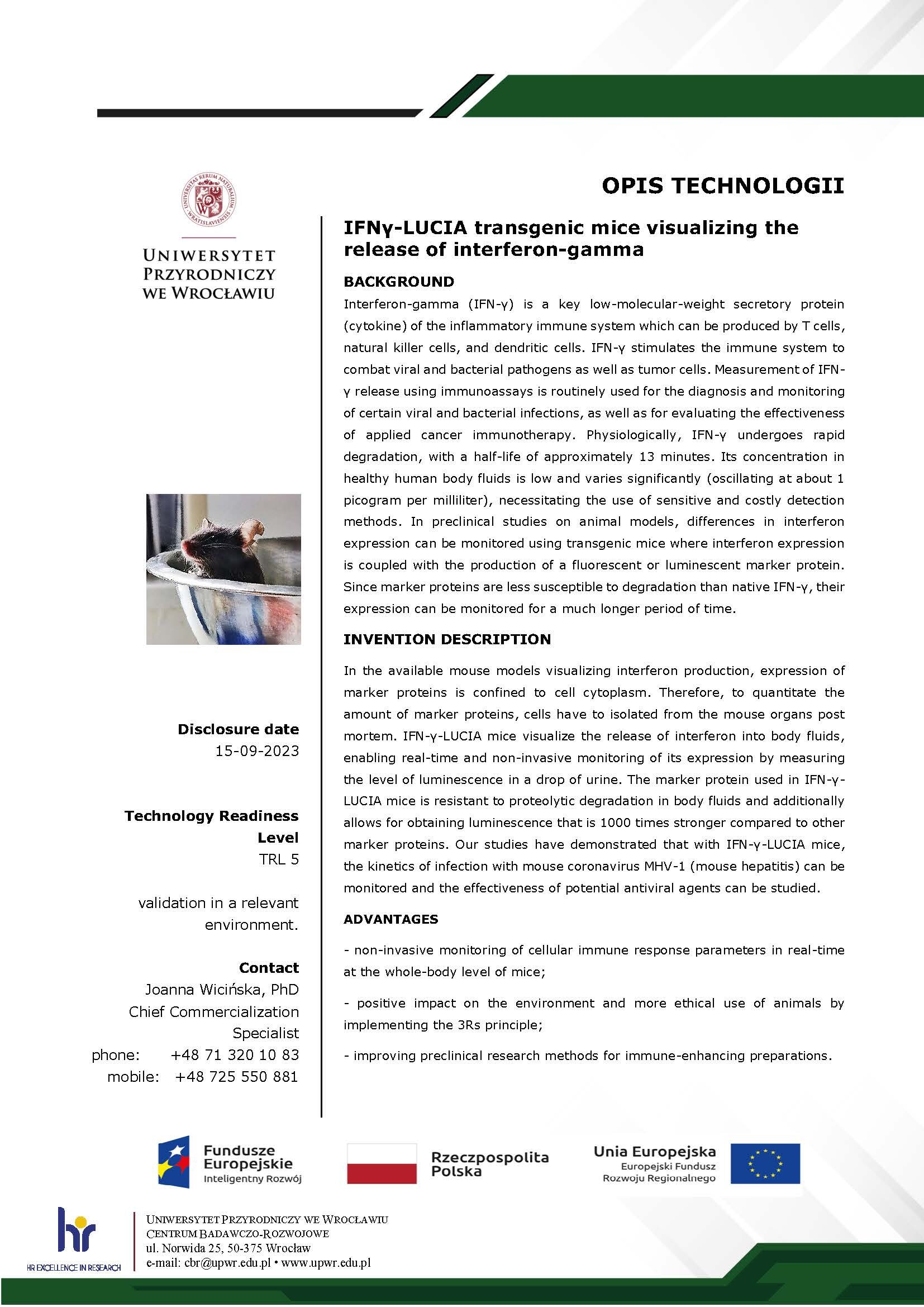 Numer oferty: 21/2023
Numer oferty: 21/2023
Technology name:
IFNγ-LUCIA transgenic mice visualizing the release of interferon-gamma
BACKGROUND
Interferon-gamma (IFN-γ) is a key low-molecular-weight secretory protein (cytokine) of the inflammatory immune system which can be produced by T cells, natural killer cells, and dendritic cells. IFN-γ stimulates the immune system to combat viral and bacterial pathogens as well as tumor cells. Measurement of IFN-γ release using immunoassays is routinely used for the diagnosis and monitoring of certain viral and bacterial infections, as well as for evaluating the effectiveness of applied cancer immunotherapy. Physiologically, IFN-γ undergoes rapid degradation, with a half-life of approximately 13 minutes. Its concentration in healthy human body fluids is low and varies significantly (oscillating at about 1 picogram per milliliter), necessitating the use of sensitive and costly detection methods. In preclinical studies on animal models, differences in interferon expression can be monitored using transgenic mice where interferon expression is coupled with the production of a fluorescent or luminescent marker protein. Since marker proteins are less susceptible to degradation than native IFN-γ, their expression can be monitored for a much longer period of time.
INVENTION DESCRIPTION
In the available mouse models visualizing interferon production, expression of marker proteins is confined to cell cytoplasm. Therefore, to quantitate the amount of marker proteins, cells have to isolated from the mouse organs post mortem. IFN-γ-LUCIA mice visualize the release of interferon into body fluids, enabling real-time and non-invasive monitoring of its expression by measuring the level of luminescence in a drop of urine. The marker protein used in IFN-γ-LUCIA mice is resistant to proteolytic degradation in body fluids and additionally allows for obtaining luminescence that is 1000 times stronger compared to other marker proteins. Our studies have demonstrated that with IFN-γ-LUCIA mice, the kinetics of infection with mouse coronavirus MHV-1 (mouse hepatitis) can be monitored and the effectiveness of potential antiviral agents can be studied.
ADVANTAGES
- non-invasive monitoring of cellular immune response parameters in real-time at the whole-body level of mice;
- positive impact on the environment and more ethical use of animals by implementing the 3Rs principle;
- improving preclinical research methods for immune-enhancing preparations.
Technology Readiness Level (TRL): 5
Disclosure date: 15-09-2023
Contact
Joanna Wicińska, PhD
Chief Commercialization Specialist
mobile: 725 550 881
joanna.wicinska@upwr.edu.pl


Jeżeli są Państwo zainteresowani naszą ofertą, mają pytania lub chcą nawiązać współpracę prosimy o kontakt z osobami, których dane znajdą Państwo w ofercie lub z Centrum Badawczo-Rozwojowe ul. Skłodowskiej-Curie 42 50-369 Wrocław


















